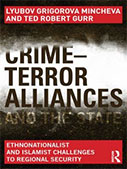Crime-Terror Alliances And The State: Ethnonationalist And
Islamist Challenges To Regional Security

Authors: Lyubov Grigorova Mincheva and Ted Robert Gurr
Publisher: Abingdon, UK; New York: Routledge, 2013. 234 p.
Reviewer: Peter Grabosky | May 2013
As the discipline of criminology matures, it has become increasingly diverse and specialized. This is as it should be, given the vast range and considerable detail of contemporary criminological phenomena. One disadvantage of this development, however, is the balkanization of criminology and the emergence of sub-disciplinary silos. Those who study organized crime have their own panels, their own journals, and indeed, their own meetings. So too do scholars of terrorism. All too rarely do these groups communicate with each other, a most unfortunate situation given the considerable and increasingly apparent interrelationship between the two fields.
Ironically, the challenge of bridging the silos of crime and terrorism has been met by some from outside the criminological profession (Makarenko 2004). Another such contribution is the present work, born of a collaboration between Lyubov Grigorova Mincheva, an associate professor of political science at the University of Sofia, Bulgaria, and Ted Robert Gurr, Distinguished University Professor Emeritus at the University of Maryland and one of the world’s foremost scholars of conflict. The book’s aim is to identify and explain the convergence of transnational organized crime and political insurgency, based on six comparative case studies — richly detailed analyses of Algeria, Bosnia, Bulgaria, Kosovo, Serbia and Turkey.
What Mincheva and Gurr refer to as “unholy alliances” arise from five general conditions: the existence of trans-state nationalist ethnic and religious movements; the occurrence of armed conflict; the accessibility of criminal markets and networks; the presence of weak or failing states; and the absence of effective supra-national institutions that might serve to rebuild these dysfunctional states. The disintegration of the former Soviet bloc and the Yugoslav Federation created a near perfect storm to this end, and provided the setting for four of the book’s case studies. Ethnic diasporas have long facilitated the provision of moral and material support for militant kinfolk; those who reside in contiguous areas of adjoining countries can be extremely helpful to this end, although more widely dispersed populations may also provide important assistance. The authors note how Kurdish populations in Southwest Asia and Europe have provided refuge and support to members of the Kurdish Workers Party (PKK). Religious ties can be similarly helpful. Islamic identity movements in Bosnia and Algeria relied initially on contributions from supporters in Middle East and Persian Gulf regions. The disintegration of Yugoslavia attracted volunteer fighters from across the Islamic world.
Abrupt political change provides opportunities and incentives for political- criminal alliances. Most of the cases presented in the book relate to events occurring in the immediate post-cold war period, where state institutions were quickly eroding, and public assets were transferred with indecent haste to private hands. Competition for power and wealth was intense, to say the least. Some actors seek one or the other; while some strive for both.
Militant groups use violence as a strategic tool, and they require access to resources both financial and material. It is therefore not surprising that they may find the skills of conventional organized criminals potentially useful. Conversely, criminals may find it strategically advantageous to link up with militant groups. Criminal and political objectives are by no means mutually exclusive. Such opportunistic interdependence may be manifest in fluid movement along the crime-terror continuum. The term “fighters turned felons” applies to those who evolve from insurgents to conventional criminals. Those who find their political chances waning may find that they can achieve a comfortable life by engaging in ‘ordinary’ crime, be it robbery, drug trafficking or ransom kidnapping. The prospect of economic gain may thus displace political objectives. Some members of the Kurdish Workers Party (PKK) appear to have followed this career path; the party began as a terrorist movement and evolved into a criminal enterprise, largely based on drug production and trafficking. One also sees the convergence of political and economic motives within groups. The Kosovo Liberation Army (KLA) exemplified this, having engaged in both drug trafficking and in armed struggle for independence. Predators may become militants, in order to achieve legitimacy in the eyes of those who favour regime change. Militants who wind up on the winning side may also become predators. Those who succeed in their political struggle may wish to enjoy the spoils of power, access to which is facilitated by reliance on illegal means and/or collaboration with criminal associates. Insurgent crime can thereby provide the basis for state crime. The authors refer to “criminalized states” such as Serbia and Bulgaria, where collusion with criminals has been commonplace.
Weak or failing states provide an ideal setting for criminals and insurgents, operating independently or in collaboration. By definition, weak states are less able to protect their borders, or provide security for their citizens. The authors refer to “ungoverned spaces” and how they constitute a hospitable environment to transnational criminal activity and cross-border insurgencies. The authors report that northern Iraq hosted PKK cannabis farms, and that Kosovo’s frontiers with Macedonia and southern Serbia have been used to stage cross-border attacks as well as to provide enclaves for the conduct of illegal transnational business.
The persistence of crime-terror alliances may also be explained in part by the absence or the limited capacity of supranational institutions that might deliver solutions. The authors devote some detail to describing the development of the EU and OSCE as ‘capable guardians’ of Europe’s periphery. While this may have occurred too late to prevent some of the conflicts in question, it certainly helped mitigate the severity of others, such as Macedonia. The lessons that have been learned thus far, combined with the improved capacity of supranational institutions, may bode well for the future.
But good intentions may be insufficient, or even counterproductive. Another interesting issue addressed in the book relates to the unintended consequences of attempts of well-meaning “outsiders” to intervene in conflict situations. The UN embargo on Yugoslavia created criminal opportunities for neighbouring Bulgarians, whose skills were easily applied to transhipment of contraband. Elsewhere, efforts to stop international money flows through legitimate financial institutions gave rise to kidnapping, extortion and robbery.
There are no easy solutions to the convergence of crime and terror discussed by Mincheva and Gurr. The authors do suggest that some degree of accommodation may be helpful. If offered opportunities for quasi-legitimate activities, there is a chance that criminals and insurgents may eventually be persuaded to enter the political and economic mainstream. Such strategies as power sharing and regional autonomy may serve these ends. Whether states or criminals or insurgents are amenable to compromise is, of course, the “sixty-four thousand dollar question.”
This book is a “must read” for specialists in organized crime and terrorism. In addition, it should be of particular interest to those who study state crime. When criminal insurgents rise to power, they often remain close to their old comrades, and retain some of their old habits. The consequences are predictable, as the case study of Kosovo suggests. The book will especially interest European scholars, given the fact that each of the criminal/political networks under analysis operates on the periphery of Western Europe. The implications for European regional security are self-evident.
To sum up, the authors observe that crime and terrorism tend to converge where there are trans-border identity networks, a climate of political instability, opportunities to exploit criminal markets, and weak or corrupt states. This cocktail of factors certainly transcends disciplinary boundaries. So too should criminologists and political scientists.
Mincheva and Gurr’s work focuses on the periphery of Europe. Perhaps for that reason it should stimulate others to explore the phenomena of unholy alliances or the crime-terrorism continuum elsewhere. For example, in Asia one thinks of Abu Sayyaf in the Philippines, the Naxalites in India, Jemaah Islamiya in Indonesia, the Tamil Tigers in Sri Lanka, and the Shan resistance in Myanmar; in Latin America, Sendoro Luminoso in Peru and FARC in Colombia; and various insurgencies across the continent of Africa including the Azawad National Liberation Movement in Northern Mali and Boko Haram in Nigeria.
The book lists at US$135, a price that does not invite a casual purchase. The electronic version costs a relatively reasonable US$42.95. One hopes that a paperback edition will soon be available, as this work of Mincheva and Gurr deserves a wide and diverse readership.
Reference
Makarenko, T. (2004). “The Crime-Terror Continuum: Tracing the Interplay between Transnational Organised Crime and Terrorism.” Global Crime, 6, 1, 129-145.
Peter Grabosky, Australian National University


